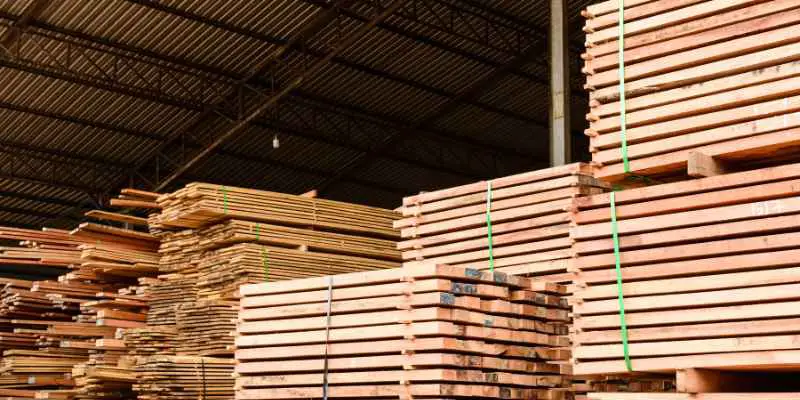The cheapest hardwood lumber to buy is poplar wood. Poplar wood is known for its affordability and availability, making it a budget-friendly option for various projects.
Whether you are a DIY enthusiast or a professional woodworker, poplar wood offers a cost-effective solution without compromising on quality. With its smooth texture and medium density, poplar wood is versatile and widely used for furniture, cabinets, trimmings, and more.
Its pale yellow color provides a neutral base that can be stained or painted to match any desired aesthetic. Additionally, poplar wood is known for its ease of workability, making it an ideal choice for both beginners and experienced craftsmen. So if you are looking for an economical hardwood lumber, poplar wood is an excellent option to consider.
Factors Affecting The Cost Of Hardwood Lumber
The cost of hardwood lumber is influenced by various factors, such as the wood species, grade, size, and availability. When looking for the cheapest hardwood lumber to buy, it is important to consider these factors to find the best value for your needs.
The cost of hardwood lumber can vary significantly based on several factors. Understanding these factors is essential if you’re looking to find the cheapest hardwood lumber to buy. The type of hardwood, grade of lumber, and availability and demand are the key factors that influence the pricing of hardwood lumber. Let’s delve deeper into each factor.
Type Of Hardwood
The type of hardwood you choose can have a significant impact on the cost. Different hardwood species vary in terms of their quality, durability, and aesthetic appeal. Some popular hardwood types include oak, cherry, maple, and walnut. While oak tends to be more affordable, exotic hardwoods such as mahogany or teak are often more expensive due to their scarcity and unique characteristics.
Grade Of Lumber
Another important factor that influences the cost of hardwood lumber is the grade of the wood. Lumber is typically graded based on its appearance and structural properties. Higher-grade lumber, such as select or FAS (first and seconds), is more expensive as it exhibits fewer defects, a more uniform color, and a smoother finish. If you are willing to overlook minor imperfections and natural variation in color, lower-grade lumber like No. 1 common or No. 2 common can be a cost-effective choice.
Availability And Demand
The availability and demand for specific hardwood lumber can also impact its cost. Lumber that is readily available and has high demand tends to be more affordable. However, rare or specialty woods that are harder to find or have a limited supply can come at a premium. Factors like location, environmental regulations, and market trends can influence the availability and demand for particular types of hardwood lumber, and subsequently, their price.
In conclusion, several factors affect the cost of hardwood lumber, including the type of hardwood, grade of lumber, and availability and demand. By considering these factors, you can make an informed decision and find the cheapest hardwood lumber that meets your specific needs and budget.

Top Affordable Hardwood Lumber Options
When it comes to purchasing hardwood lumber, cost is often a significant factor to consider. If you’re a DIY enthusiast, woodworker or just looking to complete a woodworking project without breaking the bank, it’s crucial to know the cheapest hardwood lumber options available. In this article, we’ll explore three top affordable hardwood lumber options: Red Oak, Poplar, and Ash.
Red Oak
Red Oak is a popular hardwood choice known for its durability, strength, and attractive grain patterns. It is widely available, making it one of the most affordable hardwoods on the market. With its light reddish-brown color, Red Oak is versatile and ideal for various woodworking projects.
Here are some key facts about Red Oak:
- Cost: Red Oak is considered one of the most budget-friendly hardwoods, with prices typically lower than other popular hardwoods like Maple or Walnut.
- Availability: Red Oak is widely available in most lumber yards and home improvement stores, ensuring easy access for potential buyers.
- Uses: Red Oak is commonly used for projects such as furniture, cabinets, flooring, and interior trim due to its strength and versatility.
Poplar
Poplar is another excellent option when it comes to affordable hardwood lumber. Despite not being as well-known as some other hardwoods, Poplar offers many advantages, including its cost-effectiveness, workability, and availability.
Here’s what you need to know about Poplar:
- Cost: Poplar is often considered one of the most economical hardwood lumber options, making it a go-to choice for budget-conscious woodworkers.
- Workability: Poplar is relatively easy to work with due to its softer nature. It accepts stains and finishes well, allowing for a variety of finishing options.
- Availability: Poplar is widely available, and you can find it at most lumber suppliers and home improvement stores.
Ash
Ash is another affordable hardwood lumber option that offers both durability and versatility. It features a light-colored heartwood and distinctive grain patterns, making it an attractive choice for many woodworking projects.
Consider the following points about Ash:
- Cost: Ash is generally less expensive than other hardwoods, such as Oak or Cherry. Its lower cost allows for substantial savings, especially when working on larger projects.
- Strength: Ash is known for its superb strength and durability, making it suitable for furniture, flooring, and even tool handles.
- Availability: Ash is commonly available at most lumber yards and woodworking suppliers.
These three affordable hardwood lumber options, Red Oak, Poplar, and Ash, provide cost-effective choices without compromising on quality or versatility. Whether you’re a DIY enthusiast or a professional woodworker, these hardwoods are worth considering for your next project.
Comparing The Cost And Characteristics
Looking for the most affordable hardwood lumber? Compare the costs and characteristics to find the cheapest option for your project.
When it comes to purchasing hardwood lumber, it’s essential to consider both the cost and characteristics of the wood. By understanding the price per board foot, the strength and durability, as well as the appearance and color, you can make an informed decision that fits your budget and aesthetic preferences.
Price Per Board Foot
The price per board foot is an important factor to consider when purchasing hardwood lumber. It determines the cost of each piece of wood based on its thickness, width, and length. Different hardwood species have varying price ranges, but generally, the cheapest hardwood lumber options include:
- Poplar
- Soft Maple
- Basswood
- Alder
- Butternut
These hardwoods offer affordability without compromising on quality and can be a great choice for projects where budget is a concern.
Strength And Durability
Strength and durability are crucial characteristics to consider in hardwood lumber. While the cheapest options may not have the same level of strength as more expensive hardwoods, they can still offer satisfactory durability for various projects. Poplar, for example, is known for its stability and resistance to warping, making it suitable for cabinets, furniture, and trim work. Soft Maple and Alder are also popular choices for their strength and versatility.
Appearance And Color
The appearance and color of hardwood lumber can greatly impact the overall aesthetics of your project. Although the cheapest hardwood species may not have the same striking visuals as their higher-priced counterparts, they still offer unique characteristics that can enhance your design. Poplar, for instance, has a pale yellow to light brown color and is known for its smooth grain. Butternut, on the other hand, offers a soft, light brown hue with beautiful swirls and streaks.
| Hardwood Species | Price per Board Foot (approx.) | Strength | Appearance |
|---|---|---|---|
| Poplar | $2.50 – $3.50 | Medium | Pale yellow to light brown with smooth grain |
| Soft Maple | $3.00 – $4.50 | Medium | Creamy white to light reddish-brown with straight grain |
| Basswood | $2.50 – $3.50 | Medium | Pale white to light brown with fine, uniform texture |
| Alder | $3.00 – $4.50 | Medium | Light brown with reddish undertones and straight grain |
| Butternut | $3.50 – $4.50 | Medium | Soft, light brown with swirls and streaks |
By comparing the cost, strength and durability, as well as appearance and color of the hardwood lumber options available, you can make a well-informed decision that meets both your budget and project requirements. Whether you’re working on cabinetry, furniture, trim, or other woodworking projects, the cheapest hardwood lumber options mentioned above can help you achieve a beautiful end result without breaking the bank.
Tips For Finding The Best Deal
Looking for the best deal on hardwood lumber? Discover the cheapest options available for your project without sacrificing quality. Find tips on finding affordable hardwood lumber that meets your needs.
Finding the cheapest hardwood lumber can be a challenging task, but with a little bit of research and smart shopping, you can save a significant amount of money. Here are some helpful tips to help you find the best deals on hardwood lumber:
Shop Around
When it comes to buying hardwood lumber, it pays to shop around. Check out multiple suppliers and compare prices, quality, and services. Don’t just settle for the first option you come across; take the time to explore different options. By comparing prices from different suppliers, you can find the best deal and save some cash.
Consider Buying From Local Suppliers
Supporting local businesses not only helps the community but can also save you money. Local suppliers often have lower overhead costs, which can lead to more competitive prices. Additionally, buying from local suppliers reduces transportation costs, making it a more cost-effective option. Consider reaching out to local sawmills or lumberyards to inquire about their prices and available hardwood lumber options.
Check For Promotions And Sales
Promotions and sales are perfect opportunities to score a great deal on hardwood lumber. Keep an eye out for discounts, special offers, and seasonal sales. Many suppliers advertise their promotions through their websites, newsletters, or social media platforms. Signing up for their mailing list or following them on social media can ensure you don’t miss out on any money-saving opportunities. By timing your purchase with a promotion or sale, you can get the hardwood lumber you need at a discounted price.
Conclusion
Finding the cheapest hardwood lumber requires some effort and research, but it is well worth it in the end. By shopping around, considering local suppliers, and keeping an eye on promotions and sales, you can find the best deal and save money on your hardwood lumber purchase. Use these tips to make your search for affordable hardwood lumber a success.

Frequently Asked Questions For What Is The Cheapest Hardwood Lumber To Buy
What Is The Most Affordable Hardwood?
Oak is the most affordable hardwood. It’s durable, versatile, and widely available, making it a budget-friendly option for flooring, furniture, and cabinetry.
What Is A Strong But Cheap Wood?
Oak is a strong and cost-effective wood option. It offers durability, density, and resistance to rot, making it an ideal choice for furniture, flooring, and construction projects.
What Is The Least Expensive Lumber?
Pine is the least expensive lumber. It is commonly used for construction and furniture manufacturing. With its affordability and versatility, pine is a popular choice for various woodworking projects.
What Is The Least Expensive Type Of Wood?
The least expensive type of wood is typically pine, thanks to its abundant availability and fast growth rate.
Conclusion
Finding the cheapest hardwood lumber can be a challenging task. However, by considering factors such as species, grade, and availability, you can uncover affordable options for your woodworking projects. Remember to compare prices from different suppliers, keeping in mind the quality and durability of the wood.
With careful research and planning, you can make the most cost-effective choice while still achieving exceptional results in your woodworking endeavors.


